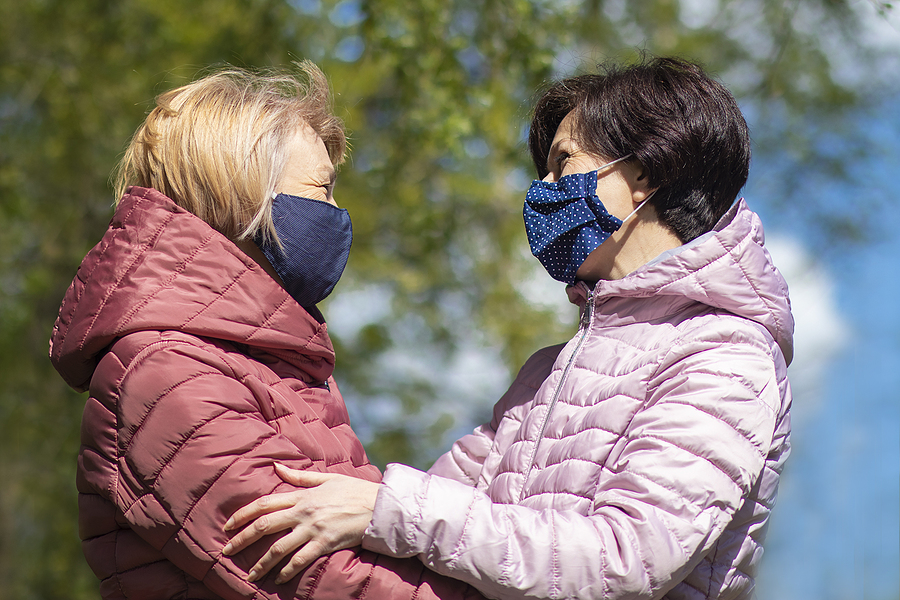Do you remember what you were doing the last week of April in 2020? Odds are, you weren’t doing much of anything as the COVID-19 lockdown was in full force in numerous areas of our nation. It was a lonely time for many people as the social isolation intended to keep us safe wore on for weeks and then months while we awaited the development of an effective vaccine.
Sadly, many lives were lost during the initial months of the pandemic — particularly among older people and vulnerable nursing home residents. However, a new study reveals that people who lived in congregate senior living communities such as continuing care retirement communities (CCRCs or life plan communities) were actually significantly less likely to die from COVID than their peers who lived in a non-congregate setting.
Additionally, once vaccines became available, residents of all types of congregate senior living communities like independent living, assisted living, and memory care were as safe or nearly as safe as their non-congregate-dwelling peers, based on excess mortality rates.
>> Related: The Senior Loneliness Epidemic Continues Post-Pandemic
Impact of COVID in senior living communities
The recent study was sponsored by National Investment Center for Seniors Housing & Care (NIC), a non-profit organization that provides analytics and insights on the senior living and care industry, and was conducted by the National Opinion Research Center (NORC) at the University of Chicago.
Researchers looked at excess mortality rates among seniors age 75 and older living in a variety of settings including those residing in their own home and those living in congregate senior living communities such as independent living, assisted living, memory care, or skilled nursing care (also called a nursing home). Residents of CCRCs — which offer residents access to a continuum of care services from independent living through skilled nursing care — were included in a secondary analysis.
Data from 2020 (prior to the vaccine’s rollout) on 3,817 senior living communities in Colorado, Connecticut, Florida, Georgia, and Pennsylvania — home to an estimated 503,000 seniors age 75 and older — was analyzed. The NORC researchers made several key discoveries:
More complex care needs, higher COVID death rates
Senior living residents with more complex health and/or caregiving needs had higher COVID mortality rates. As a result, the largest number of deaths among seniors living in congregate settings occurred among residents of memory care and skilled nursing care communities.
This finding is perhaps not especially surprising. For example, residents living in a memory care community usually suffer from various levels of cognitive decline and thus may need assistance with activities of daily living (ADLs) and instrumental activities of daily living (IADLs). As a result, infection control can be a challenge among these residents, who may neglect preventive measures like handwashing or cough etiquette.
Residents of skilled nursing care communities (aka, nursing homes) are there because they have complex health issues and require extensive, expert care around the clock. In short, they are usually older and in poorer health than other types of congregate senior living residents.
Because of their pre-existing care needs, nursing home residents often are particularly vulnerable to illnesses and may experience more serious complications if they do become ill. Sadly, because of their high-risk status, nursing home residents did succumb to COVID-related complications at a higher rate than other groups, accounting for around 25 percent of all COVID deaths.
Independent living maintained the status quo
The NORC researchers found some positive news when examining the impact of COVID on independent living communities where residents are typically younger and healthier than in care communities (particularly memory care or skilled nursing care). In fact, the study found that independent living residents had the same mortality rate, statistically, as other non-senior living community-dwelling seniors in their county.
This is an important finding because there was concern among some residents of independent living communities that they would be at a higher risk of contracting and potentially dying from COVID than their peers in the broader community. The NORC study, however, found that living in a congregate setting like an independent living community did not, in fact, increase seniors’ mortality risk during the pandemic.
Many senior living communities remained safe
The loss of life caused by COVID has been catastrophic, with the elderly and the infirm disproportionately impacted. Yet the NORC study found that many senior living communities were quite successful in keeping their residents safe and healthy even prior to the creation of an effective vaccine.
According to their analysis of 2020 data on congregate senior living settings, many communities reported no COVID-related deaths in 2020 including:
- 67 percent of independent living communities
- 64 percent of assisted living communities
- 61 percent of memory care communities
- 39 percent of skilled nursing communities/nursing homes
>> Related: Surprising Findings Around CCRC Residents’ Pandemic Stress, Resilience
Benefits of congregate living communities during COVID
The NORC study also uncovered several important points regarding the advantages that seniors in congregate living communities experienced during the pandemic as compared to their peers living outside of a senior living community.
First, senior living residents were protected, to some extent, from the potential danger of contracting COVID out in the broader world. Many communities enacted strict “lockdown” procedures to keep their residents safe, while ensuring their needs were still met.
For instance, instead of having to venture out to grocery stores, pharmacies, or other crowded public places, many senior living residents had meals, groceries, and medicines delivered to their doors. And while social distancing was paramount, many senior living communities found creative ways to keep their residents entertained and socially engaged, as compared to seniors in non-congregate settings who often felt alone and isolated during the pandemic.
But perhaps most important, senior living communities’ residents and employees were among the first people to get the initial batches of the COVID vaccine once it was authorized by the FDA. They often received priority over other seniors who lived on their own in the broader community. This vaccine triage led to earlier and better vaccine uptake rates among senior living communities.
As a result, vaccinated residents of congregate senior living communities were able to get back to a degree of normalcy sooner than other seniors. As an added benefit, vaccinated residents also had reduced stress levels and lowered their risk of isolation and loneliness, as compared to seniors living in non-congregate settings.
>> Related: The Key Difference Between Social Isolation & Loneliness
Good news for the senior living industry
The COVID pandemic understandably created a great deal of fear among many seniors as more and more vulnerable elderly people became seriously ill and died from the virus. These concerns even led some senior living residents to move out of their congregate living setting.
Yet as this NORC research reveals, residents of most types of senior living community were just as safe — or in some cases even safer — than seniors who did not live in a congregate setting. And when you factor in the benefits experienced by those living in a senior living community — such as enhanced safety precautions, added support services and amenities, socialization opportunities, and priority access to the vaccine — it is easy to see why so many senior living residents felt truly safe and cared for amid a challenging time.
This may also help explain why, as of the end of 2022, senior living occupancy rates are back to pre-pandemic levels, based on NIC data. In some cases, demand is even exceeding supply (particularly for assisted living communities). More and more people are recognizing the benefits that come with choosing a senior living community.

FREE Detailed Profile Reports on CCRCs/Life Plan Communities
Search Communities






